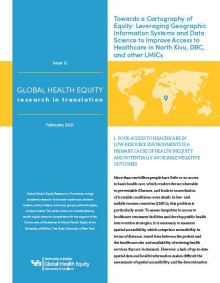Issue 12: Towards a Cartography of Equity: Leveraging Geographic Information Systems and Data Science to Improve Access to Healthcare in North Kivu, DRC, and other LMICs
Global Health Equity Research in Translation brings academic research to broader audiences: decision makers, policy makers, advocacy groups, philanthropists, and journalists. The series draws on transdisciplinary health equity research completed with the support of the Community of Excellence in Global Health Equity at the University at Buffalo, The State University of New York.
I. POOR ACCESS TO HEALTHCARE IN LOW-RESOURCE ENVIRONMENTS IS A PRIMARY CAUSE OF HEALTH INEQUITY AND POTENTIALLY AVOIDABLE NEGATIVE OUTCOMES
More than one billion people have little or no access to basic health care, which renders them vulnerable to preventable illnesses, and leads to exacerbation of treatable conditions--even death. In low- and middle-income countries (LMICs), this problem is particularly acute. To assess inequities in access to healthcare treatment facilities and develop public health intervention strategies, it is necessary to measure spatial accessibility, which comprises accessibility in terms of distance, travel time between the patient and the healthcare site, and availability of existing health services that are in demand. However, a lack of up-to-date spatial data and health information makes difficult the assessment of spatial accessibility, and the determination of the optimal location of healthcare facilities.
A further obstacle to quantifying accurate healthcare spatial accessibility in LMICs is the fact that existing data and spatial models are based on the fallacious assumption that patients will travel via publicly-documented road networks. In fact, the primary mode of travel for many patients seeking healthcare in LMICs is by foot, along the shortest routes that can be taken between one point and another--which is not necessarily utilizing an established road network.
With the support of the Community of Excellence in Global Health Equity (CGHE), an interdisciplinary team of researchers, including geographers and physicians from the University of Buffalo, has addressed this problem in recent research focusing on North Kivu, Democratic Republic of Congo.[i] The team proposed the integration of objectively measured and validated spatial accessibility metrics with a “location-allocation” model in Geographic Information Systems (GIS) to identify optimal locations of new facilities and improve planning and provision of public health services. Utilizing AccessMod[ii] with crowdsourced and remote sensing data, key inputs to the proposed model include population distribution, land use type, and elevation, which are particularly useful in rural areas of LMICs to evaluate accessibility. Candidate sites for new health facilities are derived from GIS data analysis, taking into account three different transportation scenarios: travel by foot, motorcycle, and bus. Authors report that under current conditions, most of the population “could not reach the nearest hospitals within 2-hours; only 25%, 50%, and 44% of population reached the nearest hospital within 2-hours under walking, motorcycle, and bus travel scenarios, respectively.” Using their location-allocation model, the authors illustrate that spatial accessibility could “potentially increase 11.41%, 8.29%, and 8.95% of additional population coverage for the three travel scenarios.” Given the resource limitations in LMICs, modeling locational choices for healthcare facilities remains an underexplored strategy for promoting health equity.
II. PRACTICAL TAKEAWAYS
- More than one billion people have no or limited access to basic healthcare in LMICs.
- In sub-Saharan Africa, poor access to healthcare has serious consequences, including preventable illness and death.
- Building additional healthcare facilities is a logical solution, but budgetary constraints limit the number of facilities that can be constructed. Thus, health care facilities must be sited using strategic criteria.
- The location of new healthcare facilities should be determined by assessing the spatial distribution of unmet needs, such as where the majority of the population cannot reach a hospital within 2 hours. However, an evidence-based approach can be stymied by the absence of up-to-date spatial data and health information.
- Open-source data from remote sensing and crowd sourcing offers an opportunity for civic sector decisionmakers, policy makers, politicians, and others to identify optimal locations for new healthcare facilities.
- By contributing information collected through crowdsourcing, stakeholders in LMICs can help planners and policymakers determine whether repurposing existing buildings might be appropriate, and if not, where to site new healthcare facilities.
III. POLICY TAKEAWAYS
- Access to open-sourced spatial data can help stretch limited healthcare resources in LMICs. Therefore, international agencies and country leaders must work to democratize LMIC’s access to spatial data.
- Crowd-sourced data collection can be encouraged by ministries of health as part of other citizen engagement initiatives to cultivate a sense of ownership in the identification of solutions to public health challenges.
- Decisionmakers, policy makers, politicians and others can leverage up-to-date open-source data to help characterize local, national, and regional unmet healthcare access need and determine the location of new facilities.
- Investment in GIS training programs would develop in-country capacity and enable policymakers and government officials to work with remote sensing data and make decisions informed by evidence.
ACKNOWLEDGEMENT
The information in this policy brief was extracted from Pu, Qiang, et al. (2020). Improving the spatial accessibility of healthcare in North Kivu, Democratic Republic of Congo. Applied Geography Volume 121, 102262. ISSN 0143-6228, DOI: https://doi.org/10.1016/j.apgeog.2020.102262
AUTHOR
Dr. Lisa Vahapoğlu
RECOMMENDED CITATION
Vahapoğlu, Lisa. Towards a Cartography of Equity: Leveraging Geographic Information Systems and Data Science to Improve Access to Healthcare in North Kivu, DRC, and other LMICs. Global Health Equity Research in Translation. Eds. Eun-Hye Yoo, Emmanuel Frimpong Boamah, Katarzyna Kordas, and Samina Raja. Community of Excellence in Global Health Equity, February 2021.
SOURCE TEXT
Qiang Pu, Eun-Hye Yoo, David H. Rothstein, Sarah Cairo, Luc Malemo, (2020). Improving the spatial accessibility of healthcare in North Kivu, Democratic Republic of Congo. Applied Geography Volume 121, 102262. ISSN 0143-6228. DOI: https://doi.org/10.1016/j.apgeog.2020.102262.
SERIES EDITORS
Dr. Emmanuel Frimpong Boamah, Dr. Katarzyna Kordas, and Dr. Samina Raja
DESIGN AND PRODUCTION
Nicole Little and Jessica Scates
FOOTNOTE(S)
[i] Qiang Pu, Eun-Hye Yoo, David H. Rothstein, Sarah Cairo, Luc Malemo, (2020). Improving the spatial accessibility of healthcare in North Kivu, Democratic Republic of Congo. Applied Geography Volume 121, 102262. ISSN 0143-6228. DOI: https://doi.org/10.1016/j.apgeog.2020.102262.
[ii] Developed and maintained by the WHO, AccessMod uses GIS to assess travel time and determine physical accessibility of existing healthcare sites to target populations; conduct geographic coverage analysis; analyze referral infrastructure by calculating distance and travel time between different types of health systems; estimate percentage share of the population within subnational areas who have access to health care to understand access-based inequities; identify optimal locations for new facilities.

